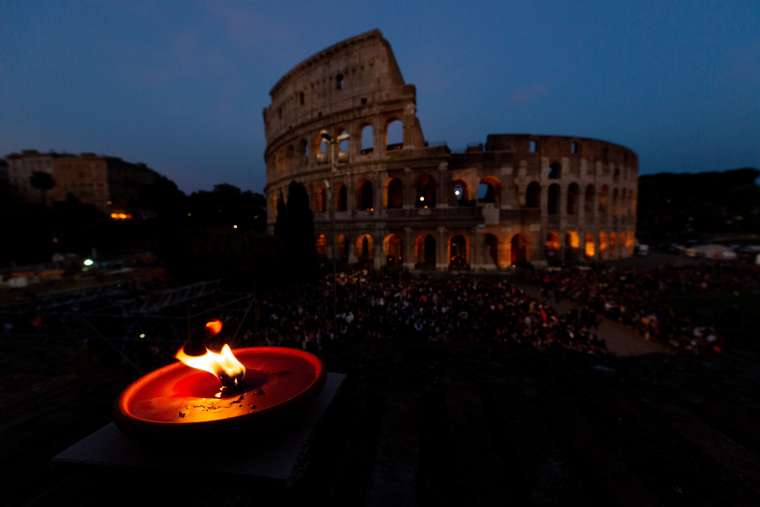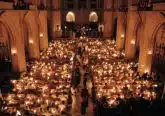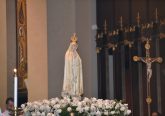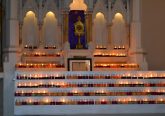Beauty, drama and pinpoint silence: Easter Triduum memories from Rome
by Hannah Brockhaus
Rome, Italy, Apr 11, 2020 / 09:00 am (CNA).- Due to the coronavirus pandemic, the 2020 Easter Triduum is looking very different for Catholics around the world, who will be praying from home and attending liturgies only through their TV or computer screens.
The situation is no different in Rome, where even the typically grandiose ceremonies of the pope have been scaled back to just a few participants at the Altar of the Chair in St. Peter’s Basilica.
As Christians reflect on the reality of the passion, death, and resurrection of Jesus Christ during these three momentous days, several Catholics living in Rome have recalled their favorite memories of the Easter Triduum in the Eternal City.
“In contrast with this year, the treasuring of those [past] experiences that I knew I was blessed and grateful to have at the time – that level of gratitude has just found a way to even deepen through this whole experience” of quarantine, Jill Alexy told CNA.
A professor and private guide, she noted that Catholics around the world enter into the solemnity of the liturgies of the Easter Triduum – which last from the evening of Holy Thursday through the evening of Easter Sunday – “but in Rome, it’s just visceral, [the spiritual feeling is] everywhere around you.”
Holy Thursday
Alexy said Holy Thursday in Rome gives her the same kind of feeling she used to get trick-or-treating as a kid.
In the center of Rome, like in other cities, after Mass of the Lord’s Supper, people participate in the tradition of visiting seven or more churches to adore Christ in the Eucharist at the altar of repose, where the hosts consecrated at Mass are preserved for use on Good Friday. A tradition from the early Church, it recalls Christ’s command to his apostles to “keep watch” with him in the Garden of Gethsemane.
The altars are typically decorated to look like gardens, with flowers and plants, and the churches are dark except for candles illuminating the altar and tabernacle.
The “treat,” Alexy explained, is getting to “have this quiet moment in this beautiful space.”
“You just have this totally quiet, silent moment with the Eucharist on Holy Thursday,” she said, recalling the back and forth of entering the quiet churches from the buzzing streets.
Paul Floersch, a seminarian for the Archdiocese of Omaha and a third-year student at the Pontifical North American College in Rome, remembered participating in the tradition in 2018 with seminary classmates, priests, sisters, and other faithful.
“To make a pilgrimage from one church to another is a joyous occasion,” he told CNA by email from the US. “The streets are full, almost entirely with people on their way from one altar of repose to another, and I specifically recall a buzz in air indicating that this joyous night was holy indeed – how blessed are we to have received so blessed a Sacrament!”
Ashley and John Noronha, a married couple living in Rome, have two favorite churches to visit on Holy Thursday. One is the Church of Santissima Trinità, where they said a “delicate fragrance of lilies” fills the space.
The white flowers point “to an experience of mystical beauty,” they said. “Candles burn on wall sconces and on the altar, as the sounds of the live angelic-like choir fill the darkness. It’s as though the darkness, which represents the great act of injustice that we remember that night, is overcome by light and sound, which penetrate the soul and take you right to the Garden of Gethsemane and the Upper Room.”
The Noronhas’ second favorite church is Santa Maria dell’Orto in Trastevere, which they said “gives the concept of catching ‘a glimpse of heaven on earth’ a whole new meaning.”
For the occasion, the church places on the altar a centuries-old structure called the “macchina delle quarant’ore,” which is made of carved and giltwood and on which are placed 144 candles.
Alexy said: “the tremendous beauty, the remarkable drama of the whole event of the ‘macchina delle quarant’ore’, the experience it provides on Holy Thursday is utterly transcendent.”
“It feels like you’ve just been whisked into the spirit of Good Friday and the fasting that is to come until the Easter Vigil.”
Good Friday
One beloved Good Friday tradition in Rome is to visit the Basilica of the Holy Cross in Jerusalem, where people may venerate relics of the true cross. In another Roman church, the Basilica of Santa Prassede, there is the pillar on which Jesus was scourged.
Another relic of Christ’s passion is the holy stairs. The holy stairs were brought to Rome by St. Helen, the mother of Emperor Constantine, and are believed to be the stairs Jesus ascended on his way to stand trial before Pontius Pilate.
Alexy explained that, though the staircase and the chapel which encases it are not widely known today, “in the past, the holy stairs were the focal point of people coming to Rome.”
“Pilgrims would walk all across Europe to come to Rome to see the tombs of the apostles Peter and Paul, to visit with the martyrs at the 40 Station Churches of Rome, but then especially to offer their filial devotion to Christ on the cross and to go up these steps on their knees,” she said.
The holy stairs can be visited year-round, but Alexy said she always tries to go around 3pm, the hour of Jesus’ death, on Good Friday, often bringing along her students.
And though the wait is hours-long, Alexy said that “getting to go up the holy stairs on my knees every year is getting to have such a close connection with the historical reality of Christ, which becomes the actual reality of the passion we live in these three days.”
Another much-anticipated Holy Week tradition is the Good Friday Stations of the Cross at the Colosseum, led by the pope.
“I can remember the first time I went as a journalist, inside the Colosseum with the media. Being able to look out on each group of people as they carried the cross from station to station,” Joan Lewis, 79, recalled. “What an awesome, awesome experience.”
Lewis, who works for EWTN and has previously been employed at the Vatican, has lived in Rome for more than 40 years. She estimates she has attended hundreds of papal liturgies and Masses.
Something she recalls from Stations of the Cross at the Colosseum is seeing “the faithful so recollected.”
“I think that’s one of the things that always struck me from so many of the papal events,” she told CNA.
“As massive as the crowds were, with huge numbers of people, for Holy Week I always sensed a very strong faith. That people were [in Rome] not just to see the pope but that it was Holy Week, the Triduum, Easter Sunday: The saddest and yet the most joyful days of the year for any Christian.”
John and Ashely Noronha recalled the same experience. “The Stations of the Cross at the Colosseum is always packed – shoulder to shoulder – with people arriving hours in advance to claim their places,” they said.
“But when the meditation on the passion of our Lord begins, annually there’s another fascinating phenomenon that occurs,” they noted. “It’s when tens of thousands of people who have been standing for hours, fall into a deep prayerful contemplation in pin-drop silence.”
Holy Saturday and Easter Sunday:
The Triduum culminates with the Easter Vigil Mass on Holy Saturday, when many catechumens are received into the Catholic faith and receive the sacraments for the first time.
Eamonn Clark, 27, is a theology student at the Pontifical University of St. Thomas Aquinas (the Angelicum). He once attended the Easter Vigil at the 5th-century Roman Basilica of Santa Sabina. As a reader, he was part of the procession into the dark church at the start of Mass.
“I just thought, wow, for 1,600 years people have been doing this exact liturgy in this exact spot,” Clark told CNA, saying he was thinking about “all of the catechumens who were received in this place, and all the papal liturgies, and all the development of the penitential rites of the Church [which] happened here and I’m getting to be involved in that.”
For Lewis, attending the Easter Sunday Mass with the now canonized popes Paul VI and John Paul II in St. Peter’s Square “was just so meaningful.”
“The joy and the beauty and the flowers. I don’t think I’d ever seen so many flowers in my life,” she said. “Whether the pope was just a little white dot, or you were close enough to see his face it was always an awesome experience.”
Lewis said she was not sure exactly what Pope Francis’ liturgies at the Vatican would look like this year, though she knew they would still “have the value it would have if there were 10,000 people present.”
For Alexy, who has also spent time in the Holy Land, for Easter, there is no place like Rome.
“I’ve loved this experience of walking the three days [of the Easter Triduum] for a long time, but I never knew how tangible and life changing it could be until I experienced it in this city,” she said.














